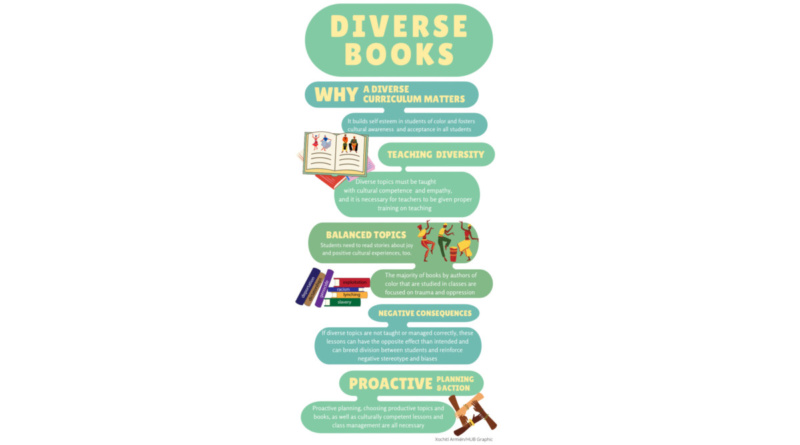OPINION: Cultural competence is key to the success of a diverse curriculum
By Xochitl Armién,
BlueDevilHUB.com Staff–
Diversity in school curriculum matters. Minority representation in the curriculum benefits both students of color and white students. Representation improves the self-confidence of students of color and fosters open-mindedness and acceptance of other cultures and people.
However, when diversifying the curriculum, it is important to pick topics and stories that don’t reinforce negative stereotypes, as well as teach sensitive topics in a way that works to dismantle any stereotypes or other negative side effects that may come up.
There are many books in Davis High English classes that are written by authors of color.
However, when it comes to the topics that these books are about, they are overwhelmingly focused on the traumas and oppression of people of color.
“Most of the books focus on the bad parts of people of color: them being slaves, them being workers who are in the fields, that’s all they’re known as,” junior Gabriel Salaices said.
Throughout history, people of color have been exploited and terrorized. At the same time, these same people were creating literature, poems, music and living lives outside of simply being victims of hate.
It is important to learn about what happened and continues to happen to people of color in America and around the world, but it becomes a problem when their trauma and oppression is the prime focus of the representation in the books and curriculum at school.
According to The Century Foundation, a diverse curriculum is supposed to help improve the self esteem of students of color. However, if students of color only see themselves represented in school as slaves, victims of hate crimes, exploited migrant workers or as negative stereotypes, this representation could have the opposite effect.
This is not the only problem. While studying sensitive topics, it is immensely important for educators to have solid strategies for managing the class and how students react to these topics. However, this does not always occur due to the fact that the many teachers are not being sufficiently trained to teach and mediate discussions about these topics.
The Davis Joint Unified School District does not currently mandate training for how to teach sensitive topics surrounding race, yet expect skillful facilitation of these conversations.
English teacher Pernia Hassan feels that ongoing teacher training is necessary.
“It’s not like you can go to one professional development week and suddenly you’ve overcome your racial biases and your prejudices,” Hassan said.
When white fragility and defensiveness come into play, the lesson can go from productive and uplifting to tearing people apart.
Sophomore Gabrielle Naftel witnessed a class discussion go south as students shut down after a student of color made a comment. She explains that most of the students rejected the idea that they may have made a mistake, and jumped to the conclusion that they were being accused of something.
“The primary reaction was defensiveness. People wanted to explain and justify (themselves) and thought they were being accused of racism,” Naftel said.
Eric Sanchez, the Diversity & Inclusion Educator and Specialist at UC Davis said that there are two paths that the district should pursue in order to begin to fix some of the issues that come up while diversity is implemented in classrooms.
“One is the reactive path: what do we do in response to the harm that has already been caused. And the other is the proactive path: how we intentionally and proactively look at the curriculum from the mistakes of the past and make it better the next time around so that the future folks who go through it don’t go through the same issues,” Sanchez said.
As far as the method of delivery for teaching these sensitive topics, Sanchez explained that the topics need to start being taught at a basic level. He uses the analogy that the books being studied are essentially the final calculus level of learning diverse subjects.
“You wouldn’t drop a kindergartener into calculus but that’s where you started students as learners. They weren’t equipped to get to that point. So what’s an earlier starting point?” Sanchez said.
Hassan suggested that an earlier starting point would be to extend ethnic studies curriculum to begin as early as kindergarten.
“I really do think that if we started talking about this from a much much earlier age we would be overcoming our biases,” Hassan said.
For a diverse curriculum to be beneficial for students, the district needs to provide sufficient training for teachers, a well rounded spectrum of books that represent the richness of cultural identities, and take measures to prevent identity-based harm and promote cross-cultural appreciation.




